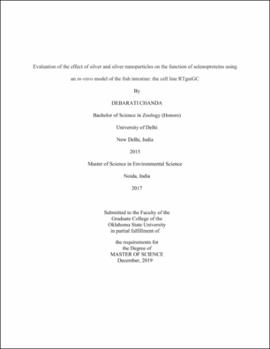| dc.contributor.advisor | Minghetti, Matteo | |
| dc.contributor.author | Chanda, Debarati | |
| dc.date.accessioned | 2022-01-09T19:54:57Z | |
| dc.date.available | 2022-01-09T19:54:57Z | |
| dc.date.issued | 2019-12 | |
| dc.identifier.uri | https://hdl.handle.net/11244/333671 | |
| dc.description.abstract | The long-term adverse effects of silver (Ag) and silver nanoparticles (AgNP) on human and environmental health is a concern. Moreover, recent research in mammalian cells has clearly indicated detrimental inhibitory effects on vital selenoenzymes playing an important role in oxidative stress control. Therefore, any disruption of selenoprotein function can be detrimental to organismal health. Our primary objective is to test the inhibitory effects of Ag exposure in the form of silver salt (AgNO3) and citrate coated silver nanoparticle (cit-AgNP) on selenoprotein function using a fish cell line derived from the Rainbow trout (Oncorhynchus mykiss) intestine (RTgutGC). Following exposure to non-toxic and toxic concentrations of AgNO3 and cit-AgNP, glutathione peroxidase (GPx) and thioredoxin reductase (TrxR) function was evaluated by measuring their mRNA levels and enzymatic activity. Oxidative stress was measured using glutathione reductase (GR) mRNA levels and ROS formation by using the CM-H2DCFDA assay. Metal bio-reactivity was evaluated by measuring Metallothionein b (MTb) mRNA levels. Intracellular accumulation of silver was measured by ICP-OES. Toxicity in RTgutGC cells was evaluated using the alamarBlue and CFDA-AM assay. Our results showed that cells exposed to equimolar amounts of AgNO3 and cit-AgNP accumulated the same amount of silver intracellularly, however, AgNO3 induced more cytotoxicity. Moreover, mRNA levels for MT increased at 24 hours (h) of exposure, confirming the uptake of silver by cells, while no induction was observed at 72 h suggesting scavenging of intracellular silver by MT. The mRNA levels for the target selenoenzymes (GPx and TrxR), however, remained unchanged, indicating that silver uptake had no effect on selenoproteins gene expression. However, an inhibition in activity of GPx was observed in cells exposed to toxic doses of AgNO3 (1 uM) and cit-AgNP (5 uM), while the TrxR activity was inhibited in cells exposed to AgNO3 (0.4 uM) and cit-AgNP (1, 5 uM). No induction of oxidative stress response was observed after AgNO3 or cit-AgNP exposure. Overall, our study clearly established that silver exposure induces an inhibitory effect on target selenoenzymes (GPx and TrxR) activity level but not at the transcriptional level. | |
| dc.format | application/pdf | |
| dc.language | en_US | |
| dc.rights | Copyright is held by the author who has granted the Oklahoma State University Library the non-exclusive right to share this material in its institutional repository. Contact Digital Library Services at lib-dls@okstate.edu or 405-744-9161 for the permission policy on the use, reproduction or distribution of this material. | |
| dc.title | Evaluation of the effect of silver and silver nanoparticles on the function of selenoproteins using an in-vitro model of the fish intestine: The cell line RTgutGC | |
| dc.contributor.committeeMember | Jeyasingh, Puni | |
| dc.contributor.committeeMember | Belden, Jason | |
| osu.filename | Chanda_okstate_0664M_16551.pdf | |
| osu.accesstype | Open Access | |
| dc.type.genre | Thesis | |
| dc.type.material | Text | |
| dc.subject.keywords | agno3 | |
| dc.subject.keywords | cit-agnp | |
| dc.subject.keywords | glutathione peroxidase | |
| dc.subject.keywords | rtgutgc | |
| dc.subject.keywords | selenoprotein enzymatic activity | |
| dc.subject.keywords | thioredoxin reductase | |
| thesis.degree.discipline | Integrative Biology | |
| thesis.degree.grantor | Oklahoma State University | |
